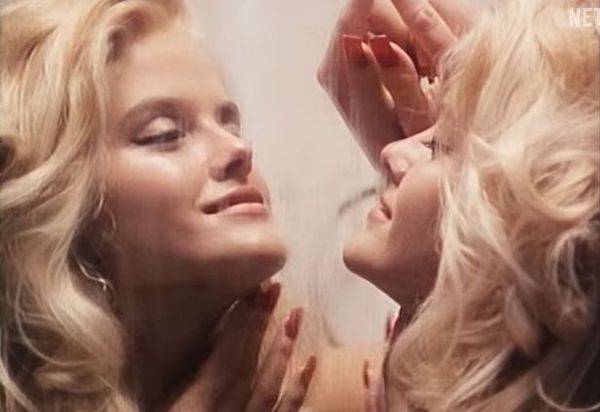Television Review: “Anna Nicole Smith: You Don’t Know Me” — A Hypocritical Homage
By Sarah Osman
The documentary tries to tell the story of the real Anna Nicole Smith, but it falls short.

A scene from Netflix’s Anna Nicole Smith: You Don’t Know Me.
Some are nostalgic for the late ’90s and early 2000s — Y2K fashion has made a comeback. Others are turning a critical eye on the period. Multiple documentaries have been released questioning what the hell went wrong. Most of these focus on hypersexualization, and how a succession of “it” girls were sensationalized for profit by a complicit media. One of these victimized ladies was the infamous Anna Nicole Smith, a former Playboy bunny and reality star who sadly passed away from an overdose in 2007. In Anna Nicole Smith: You Don’t Know Me, director Ursula Macfarlane asked interviewees a question that wasn’t considered in the early oughts: Who really was Anna Nicole Smith?
Unfortunately, the doc’s attempts to supply an answer falls short. Anna Nicole Smith was initially born Vickie Lynn Hogan in a small Texas town named Mexia. Her family remembered Vickie as a bright, vivacious young girl who thrived on attention. She certainly succeeded in becoming the center of attention in Mexia; a family member recalls going to the mall with her and having some 50 men and boys trailing after her. Wanting to escape her town, a jealous husband, a supposedly abusive family, and to support her son, Vickie headed to Houston’s topless clubs. She became a prolific exotic dancer.
At this point the narrative begins to probe the more mysterious aspects of Smith’s personality and life. According to her friend Melissa “Missy” Byrum, she and Smith were lovers. Smith was a bisexual? That is an intriguing bombshell that is dropped and then forgotten. It turns out that Byrum provides the film’s most revealing tidbits. She later became Smith’s personal assistant and spent time with her son, Daniel, who Smith deeply loved. She also witnessed Smith’s relationship with the 86-year-old billionaire oil tycoon J. Howard Marshall II, whom she refused to marry until she made a name for herself by establishing a career in showbiz.
And make a name for herself Smith did. But it didn’t happen overnight. Recalling her first shoot for Playboy, photographer Marily Grabowski notes how nervous Smith was. She had no idea how to pose, and that is a serious problem for a performer. It wasn’t until Grabowski put on the Marilyn Monroe record “Diamonds Are a Girl’s Best Friend” that Smith was inspired, proving that she could be as alluring as her idol. And, like the elusive Marilyn, Smith quickly became the obsession of paparazzi, who loved how “animated” she was.
At this point the documentary takes a soap opera turn. One misfortune is hurled at Smith, one right after the other, and it’s hard not to share in her despair. First, Smith located her estranged biological father and he promptly tried to sleep with her. After that, she upped her prescription use. Then her husband passed away, and Smith faced a lengthy legal trial to receive her inheritance. Of course, this event was a field day for the paparazzi, and they sensed and then preyed on Smith’s emotional vulnerability. Smith’s decline is bleak than tragic, a fall that seems to be tailor-made to make headlines. Then the documentary takes yet another turn: Byrum drops the bomb that Smith lied to the press about her family, especially her mother, physically and sexually abusing her. Byrum came up with that story. According to Smith’s mother, her daughter embraced this narrative because the sadder her circumstances, the more money she made.
That statement suggests what this documentary should really have been about. The media loves misery because it sells, and Smith’s lies cement that. But, because the doc waits to tell us that Smith made things up, you are left wondering if anything she said was true, and that diminishes some of your sympathy for her. Was Smith actually abused? Did her father really try to have sex with her? On top of that, Anna Nicole Smith: You Don’t Know Me includes some of Smith’s most notorious stunts, such as her appearance at the 2004 MTV Video Music Awards. Doesn’t rehashing these incidents end up exploiting Smith as much as the tabloid press did? The proliferation of celebrity biopics, juiced up by streaming services like Netflix, hungry for quick and easy fables of tortured eye candy, should be seen for that it is: manipulation. Smith’s kindred spirit, Marilyn Monroe, also got a recent biopic that claimed that it intended to show us who she truly was. Blonde was a complete disaster. There was much more to Marilyn – and to Smith – that these films would have us believe. But don’t expect significant revelations from the current wave of hypocritical homages to sex goddesses.
Sarah Mina Osman is a writer residing in Wilmington, NC. In addition to writing for the Arts Fuse, she has written for Watercooler HQ, Huffington Post, HelloGiggles, Young Hollywood, and Matador Network, among other sites. Her work was included in the anthology Fury: Women’s Lived Experiences in the Trump Era. She is currently a first year fiction MFA candidate at the University of North Carolina Wilmington. When she’s not writing, she’s dancing, watching movies, traveling, or eating. She has a deep appreciation for sloths and tacos. You can keep up with her on Twitter and Instagram: @SarahMinaOsman
Tagged: Anna Nicole Smith, Anna Nicole Smith: You Don’t Know Me, Netflix

